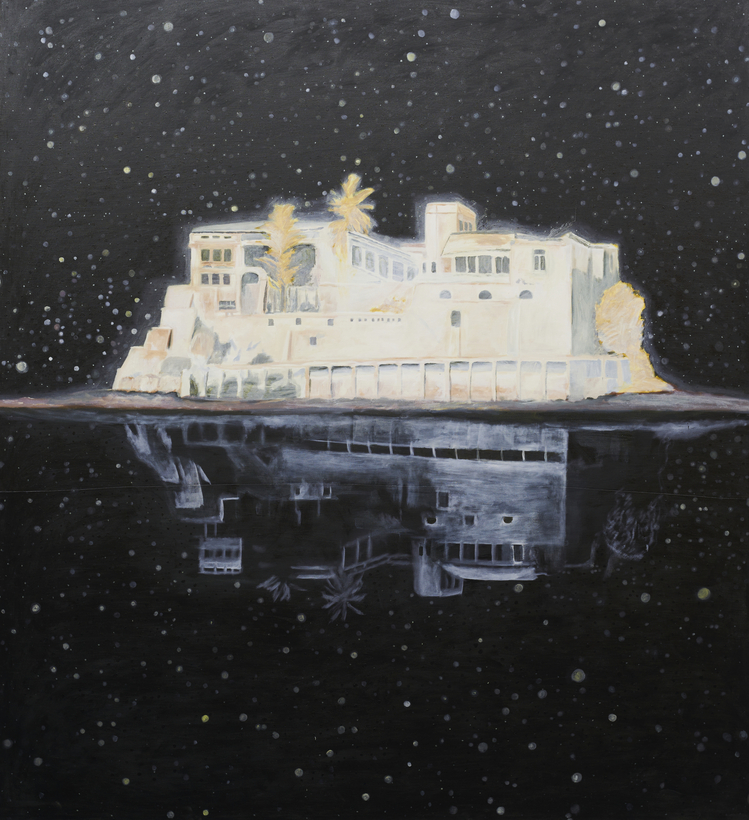Gideon Appah is a master of romance. The Accra-based artist creates landscapes full of atmospheric elements: clouds, stars, expanses of desert—realms that have been described as “primordial” and “post-apocalyptic.” He populates these spaces with contemplative and unknown figures, perfectly poised members of the canvas who hang out or drift through. Appah first started working with Ghanaian newspaper clippings, but now he paints on layered canvas, a technique that sees him coloring from dark to light rather than from light to dark. The result is a muted, strangely disembodied color palette, one that seems to exist somewhere between heaven and earth.
The modest and affable Appah, now 34, is making a splash in the art world. In 2022, he’s received solo shows at Ghana’s esteemed Gallery 1957 and the Institute for Contemporary Art at Virginia Commonwealth University. With an exhibition of Appah’s recent works having opened last week at the Triennale in Milan, AIR MAIL catches up with Ghana’s hottest young artist.
ELENA CLAVARINO: When did you start painting? And was there a moment when you realized you wanted to be an artist?
GIDEON APPAH: I used to make drawings on walls. And then I started with watercolors, then on paper. I was very young, and I was one of the best in my class. The interest was from childhood. But when I got to the third year of university, I had a crisis. I just didn’t know what I was going to do [for] a job. I realized I had to stay with what I know. And develop. So my journey has always been about that. I’m painting and developing my skills. I haven’t really arrived yet.

E.C.: Tell me about living in Accra.
G.A.: Accra is O.K. I grew up here. I come from a family of five. My mother, my dad, and then the two guys, and then a girl. So, I’m in the middle. Then I went to university at the Kwame Nkrumah University of Science and Technology—it has an art department. I went to make paintings.
E.C.: You look at newspaper clippings to create your works, right? And you draw from history in some of your work?
G.A.: Yeah, so I worked with newspaper clippings. They mostly date back to the 70s and 80s. Newspaper clippings give me ideas on a broad scope. Because when you look at the newspaper you might see an interior, or someone’s face—a posture. Or you might see pictures of buildings or a waterline, or maybe there’s a parliamentary gathering. So I steal those images, and I combine them.
E.C.: When did you begin working with muted colors?
G.A.: The newspapers came first. Then the muted-color thing started with mixtures. I prime the canvas white, then I do five layers [of color] on top. So when the color goes on the canvas, it’s a bit eerie. It’s actually black. Black is my base, and every color goes on black, so I try to find light. Pursuing light in the black space.
E.C.: You also do work in red?
G.A.: I have always been attached to red. One way or the other I keep coming back to it. I add figures in the background because I don’t want them too present. It’s like playing with notes in music, high notes, low notes, things like that.
E.C.: And who are these figures that you paint?
G.A.: Today it’s figures that are not necessarily in their natural environment. The figures are mostly ideas for me. I just play with colors.
E.C.: Many of them aren’t very detailed. Are they meant to be mysterious?
G.A.: Not necessarily. They become highlights in the painting. They are the wanderers. They’re mysterious people in the sense that you don’t know what they are doing in the work. They just bring things together. The very first one I did, it was a big, long canvas, and I put a figure on a horse in the top right. It blended very well with the landscape. And that became the mystery. It reminded me of watching a movie of a man on a horse, riding, in a vast land of infinite space.

E.C.: Do you have a routine?
G.A.: Most of the time I start at 10. But I don’t work every day. If I’m supposed to go to the studio, and I have a bad day, I just fold up and go home and come back the next day. At first, I used to have a lot of bad days. I wouldn’t destroy the work; I just put it on the side. I go home, sleep on it, come back the next day. Most of the works that people say are great paintings are those ones that I pack on the side and come back to later.
E.C.: What is in your show in Milan?
G.A.: It’s a blend of figures and landscapes. The first one I did was the white one—with the newspapers, using pictures of buildings that I’ve found from the 70s and 80s. So, then I went through the laborious task of putting all those stars around them. Then we are showing four red landscapes, but we’re not actually showing everything. I think you’d like the dancers very much.
E.C.: Can you describe the painting?
G.A.: It’s a group of people dancing in the middle of blue sky and mountains. If I’m painting figures, I normally would like to add a certain kind of activity. Activity is important. We just don’t wake up to do nothing—we need to do something. We need to work, we need to drive, we need to drink, and so on. So I want to capture figures in certain moments like that. I’m sure you’ll love it. The dancing is cool. Very … dreamlike.
Gideon Appah’s show “Unknown Unknowns: An Introduction to Mysteries” is on view at the 23rd International Exhibition at Triennale di Milano through December 11
Elena Clavarino is an Associate Editor for AIR MAIL

 Discover
Discover